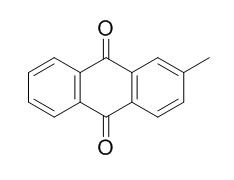Tectoquinone
Tectoquinone exhibits strong mosquito larvicidal activity.
Inquire / Order:
manager@chemfaces.com
Technical Inquiries:
service@chemfaces.com
Tel:
+86-27-84237783
Fax:
+86-27-84254680
Address:
1 Building, No. 83, CheCheng Rd., Wuhan Economic and Technological Development Zone, Wuhan, Hubei 430056, PRC
Providing storage is as stated on the product vial and the vial is kept tightly sealed, the product can be stored for up to
24 months(2-8C).
Wherever possible, you should prepare and use solutions on the same day. However, if you need to make up stock solutions in advance, we recommend that you store the solution as aliquots in tightly sealed vials at -20C. Generally, these will be useable for up to two weeks. Before use, and prior to opening the vial we recommend that you allow your product to equilibrate to room temperature for at least 1 hour.
Need more advice on solubility, usage and handling? Please email to: service@chemfaces.com
The packaging of the product may have turned upside down during transportation, resulting in the natural compounds adhering to the neck or cap of the vial. take the vial out of its packaging and gently shake to let the compounds fall to the bottom of the vial. for liquid products, centrifuge at 200-500 RPM to gather the liquid at the bottom of the vial. try to avoid loss or contamination during handling.
Int J Mol Sci.2021, 22(21):11836.
Mutlu Yanic S, Ates EG. JOTCSA.2023, 10(4);893-902.
Antioxidants.2022, 11(3):491.
Virus Res.2023, 335:199199.
Nat Prod Sci.2018, 24(2):109-114
Front Cell Dev Biol.2021, 9:588093.
Int J Mol Sci.2023, 24(17):13230.
Molecules.2021, 26(2):E255.
Enzyme Microb Technol.2022, 161:110111.
Plant Physiol Biochem.2021, 160:166-174.
Related and Featured Products
Bioresour Technol. 2008 Jun;99(9):3617-22.
Larvicidal activity of tectoquinone isolated from red heartwood-type Cryptomeria japonica against two mosquito species.[Pubmed:
17804221]
METHODS AND RESULTS:
Mosquito larvicidal activities of methanolic extracts from different plant parts of red heartwood-type Cryptomeria japonica D. Don against the fourth-instar larvae of Aedes aegypti and Aedes albopictus were examined. Results of mosquito larvicidal tests demonstrated that the n-hexane fraction of C. japonica sapwood methanolic extract had an excellent inhibitory effect against the larvae of A. aegypti and A. albopictus and its LC50 values were 2.4 and 3.3 microg/ml, respectively, in 24h. Following the bioactivity-guided fractionation procedure, the active constituent isolated from C. japonica sapwood was characterized as Tectoquinone by spectroscopic analyses. The LC50 values of Tectoquinone against A. aegypti and A. albopictus in 24h were 3.3 and 5.4 microg/ml, respectively. In addition, comparisons of mosquito larvicidal activity of anthraquinone congeners demonstrated that anthraquinone skeleton with a methyl group at C-2 position, such as Tectoquinone, exhibited the strongest mosquito larvicidal activity.
CONCLUSIONS:
Results of this study show that the methanolic extract of C. japonica sapwood may be considered as a potent source and Tectoquinone as a new natural mosquito larvicidal agent.



